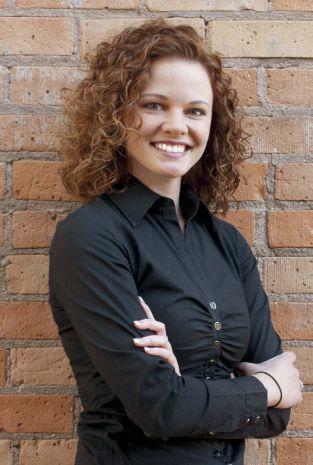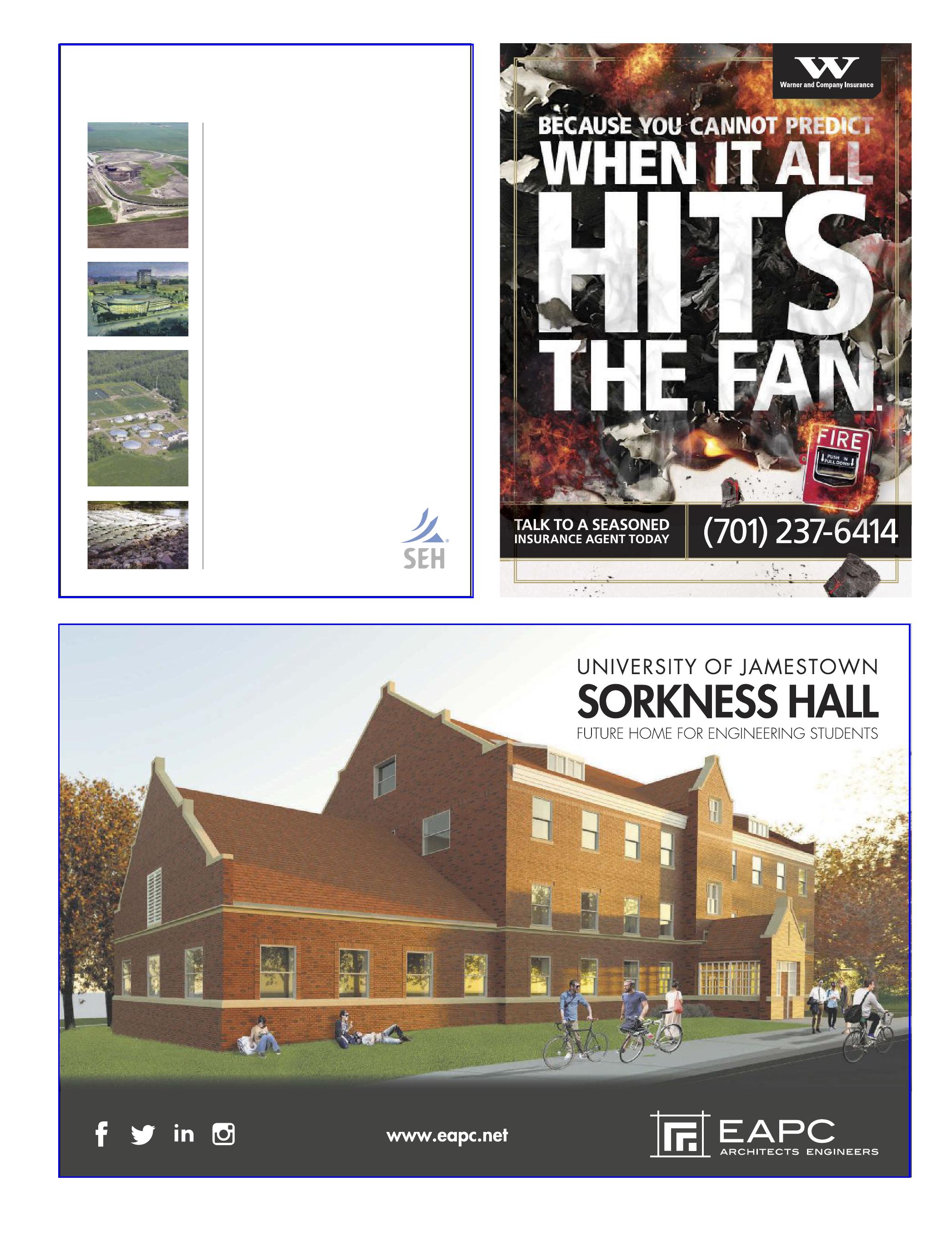High-Impact Development

Fargo-Moorhead metro encourages innovation, entrepreneurs
pg. 30
Classroom to Career
Mentors guide college students on paths to chosen professions
pg. 36
Advances in Architecture
Renewable energy, modern materials boost efficiency
pg. 40
June 2016

For the one who said, “I would not have been President had it not been for my experience in North Dakota,” a Presidential Library and Museum reflective of the man who loved our great state as much as we do.

A BULLY PULPIT
jlgarchitects.com 100% EMPLOYEE OWNED #1 Architecture Firm, Inc 5000 | #19 Architecture Magazine Top 50 US Firm | PSMJ Circle of Excellence | Zweig Group Hot Firm Prairie Business Top 50 Places to Work | Building Design+Construction Top 300 Architecture Industry Giant CONCEPTUAL IMAGE | THEODORE ROOSEVELT PRESIDENTIAL LIBRARY FOUNDATION
BY LISA GIBSON Experience, Entrepreneurs
 MATTHEW D. MOHR Standards Influence
BY DELLA KAPOCIUS
BY JACKIE ZAMORANO
MATTHEW D. MOHR Standards Influence
BY DELLA KAPOCIUS
BY JACKIE ZAMORANO
Minnesota State University Moorhead is expanding its degree offerings in an effort to help resolve the workforce shortage in the Fargo, West Fargo and Moorhead area. This month’s Community Profile focuses on the three neighboring cities’ business environments. Read more on page 28.

 SHERRY D. SAMSON
Team
SHERRY D. SAMSON
Team
4 Prairie Business June 2016 |INSIDE| June 2016 VOL 17 ISSUE 6 FEATURES DEPARTMENTS
Editor's Note
6
and Architecture
Business Advice
Culture
Funding
Federal
to Launch Small Businesses
Employee Engagement
Build and Keep an Engaged
14 Security
Data Protection and Cyber Liability 16 Prairie News 23 Prairie People 26 Business Insider Entrepreneurial Spirit Two architects build successful firm from the ground up 42 Construction Corner Merging Old and New Augustana University invests in science with Froiland Complex 46 By the Numbers 48 Federal Drilling Data Next Month The July issue of Prairie Business will focus on health care and banking/ finance. It also will include another edition of the popular Corporate Communities special section. ON THE COVER: The view of the iconic Fargo Theatre in downtown Fargo, N.D. IMAGE: MIKE VOSBURG/ FORUM NEWS SERVICE 30
West Fargo and Moorhead are ideal for new business Follow us on Twitter https://twitter.com/PrairieBiz Check us out on Facebook https://www.facebook.com/PrairieBusiness
8
BY
10
Grants
12
BY
'A Big-City Feel' Fargo,
CONVENTION & VISITORS
for the Times N.D. vet clinic incorporates modern materials and geothermal energy
of
College students get real-world
through mentors, innovative curriculum
IMAGE: FARGO-MOORHEAD
BUREAU 40 Design
36 Language
Leadership
experience











 LISA GIBSON Editor 701.787.6753
LISA GIBSON Editor 701.787.6753

lgibson@prairiebusinessmagazine.com

Experience, Entrepreneurs and Architecture
Ididn’t know I wanted to be a journalist until I was well into my college career and had switched majors three times. On the fourth change-up, I finally landed on writing as a career path, but it was an accident.
I had registered for a community journalism course at the University of North Dakota in Grand Forks, thinking it would be a few valuable credits, not a rerouting of my career path. An assignment in that class required me to convince a local publication of any kind to publish my work. Imagine a 20-year-old me nervously begging a Grand Forks Herald city editor to publish my first attempt at a news article and you have the beginning of my writing career. That assignment resulted in my internship at the Herald, which led to my first part-time general assignment reporting gig, my first full-time beat reporting job and a number of other positions I held as I made connections, met important people and worked my way to where I am today.
It was humbling and scary at the time, but that journalism professor saw the value in forcing college students out into the world. The jump from school to career is not usually simple and it’s certainly not obvious for many young people. In the higher education feature starting on page 36, we explore some of the mentor and leadership programs universities in the region offer their students to bridge that gap with real-world experience. Whether they’re being paired with a local professional in their anticipated career field or partnering with local organizations to do service work, students gain value and experience from those programs, and most schools are seeing increases in the number of students who want to participate in them.
This issue of Prairie Business also includes the Community Profile of neighboring cities Fargo and West Fargo in North Dakota and Moorhead, Minn. In an incredibly useful discussion with city and business leaders from those communities, entrepreneurism emerged as a central theme to the business environments there. That comes as no surprise to anyone familiar with the Fargo-Moorhead metro area, where new companies and organizations are sprouting up all the time. The three cities also boast a strong construction and development industry, and innovative measures to recruit and retain an efficient workforce. Read more about what the communities’ own leaders have to say about their cities on page 30.
The third and final feature in this issue spotlights a veterinary clinic in southwest North Dakota that incorporates two design elements for optimal energy, cost and insulation efficiency. The architect on the project says pairing geothermal heating and cooling with structural insulated panel construction creates the perfect scenario for savings. Read more about it on page 40.
Experience, entrepreneurs and architecture only touch on part of what we have in store for you in this edition of Prairie Business. Read on. PB
6 Prairie Business June 2016 |EDITOR’S NOTE|
KORRIE WENZEL, Publisher
STACI LORD, Ad Director
LISA GIBSON, Editor
KAYLA PRASEK, Staff Writer
BETH BOHLMAN, Circulation Manager
KRIS WOLFF, Layout Design, Ad Design

Account Executive: NICHOLE ERTMAN
800. 477.6572 ext. 1162
nertman@prairiebusinessmagazine.com
Prairie Business magazine is published monthly by the Grand Forks Herald and Forum Communications Company with offices at 375 2nd Avenue North, Grand Forks, ND 58203.
Qualifying subscriptions are available free of charge. Back issue quantities are limited and subject to availability ($2/copy prepaid). The opinions of writers featured in Prairie Business are their own. Unsolicited manuscripts, photographs, artwork are encouraged but will not be returned without a self-addressed, stamped envelope.
Subscriptions Free subscriptions are available online to qualified requestors at www.prairiebusinessmagazine.com
Address corrections
Prairie Business magazine
PO Box 6008
Grand Forks, ND 58206-6008
Beth Bohlman: bbohlman@prairiebusinessmagazine.com
Online www.prairiebusinessmagazine.com
7 www.prairiebusinessmagazine.com
Prairie premier business
Business
magazine of the northern plains
A B BUSINESS SOLUTIONS .................... 8 ACKERMAN-ESTVOLD .......................... 33 ADVANCED ENGINEERING .................. 19 ALERUS FINANCIAL .............................. 15 APEX ENGINEERING GROUP ............... 47 ARTEKTA INC. ........................................ 13 BASIN ELECTRIC .................................... 49 BREMER FINANCIAL SERVICES ........... 11 CIVIL DESIGN INC. ................................. 27 COMMISSIONING SOLUTIONS .......... 29 COMMISSIONING SOLUTIONS ........... 33 DAKOTA CARRIER NETWORK ............. 50 EAPC ARCHITECTS ENGINEERS .......... 35 EIDE BAILLY ........................................... 45 GATE CITY BANK ................................... 27 HOUSTON ENGINEERING .................... 15 ICON ARCHITECTURAL GROUP ............ 7 INTERSTATE ENGINEERING ................. 43 UNIVERSITY OF JAMESTOWN............. 19 JLG ARCHITECTS ..................................... 3 KLJ ............................................................. 5 LJA ........................................................... 41 MANNING MECHANICAL INC. ............ 29 MINOT STATE UNIVERSITY ................. 39 MSUM...................................................... 37 ND DEPT OF COMMERCE ...................... 2 ND GUARANTY & TITLE CO ................. 43 NISC ......................................................... 23 ANY DOOR MARKETING ...................... 29 SEH INC ..................................................... 5 STARWOOD HOTELS & RESORT ........... 9 ULINE HEADQUARTERS ....................... 17 ULTEIG ENGINEERS .............................. 39 UMC RELATIONS ................................... 17 VAALER INSURANCE/HCIS .................. 25 WARNER & CO INSURANCE................. 35 WIDSETH SMITH & NOLTING .............. 37 |ADVERTISER DIRECTORY|
Standards Influence Culture
BY MATTHEW D. MOHR
In addition to target revenues and profits, business owners determine policies for their enterprises that involve a multitude of things from cleanliness to what employees are expected to wear. All of these standards and expectations create an organization’s culture. Stricter standards usually translate to more dominant management, which in today’s work environment is hard to maintain.
When a business owner decides not to properly care for property, a message is sent to employees and customers that sloppiness is acceptable and to expect sloppy workmanship. The millennial generation (as did the baby boomers) grew up being told people should not be judged by their appearance. Baby boomers understood this was meant as a caution against bias, prejudice and unsubstantiated criticism. Millennials have taken it as a standard and are much more likely to accept people and things as they are, but as a consequence resist rules and dominant cultural values. If a person wants to skip a haircut for a year or not shower for a few weeks, millen-
nials don’t judge, while baby boomers suggest the person get cleaned up.
Regardless of what we have been told or think we believe, most of us judge others, and impressions do influence our decisions.
T-shirts and blue jeans with holes are not acceptable attire in all circumstances (a funeral or wedding, for example), yet the “don’t judge them attitude” makes some think anything is acceptable anywhere.
As we look toward the quality of our organization, few business owners want a “good enough” culture to be the prevailing attitude of employees. Building a culture based on honesty, working for customers and dedication to do the right things is part of leading an organization. Failing to set standards and improve an organization over time leads to business failure.

The standards a business sets determine the culture created. PB
Matthew D. Mohr CEO, Dacotah Paper Co. Fargo, N.D. mmohr@dacotahpaper.com
8 Prairie Business June 2016 |BUSINESS ADVICE|

9 www.prairiebusinessmagazine.com Sustain Element Hotels Productivity can’t be achieved without balance. That’s why we go beyond business tools to offer our guests what they need to stay whole, like bikes to borrow, spaces flooded with daylight, Relax evening wine receptions, healthy grab ‘n go meals and more. Discover the essentials of balanced travel. Extended Stay Reimagined Element Fargo Book now at elementhotels. com © 2016 Starwood Hotels & Resorts Worldwide, Inc. All Rights Reserved. Preferred Guest, SPG, Element and their logos are the trademarks of Starwood Hotels & Resorts Worldwide, Inc., or its affiliates. Chandler, AZ ⚫ Aspen, CO ⚫ Denver, CO ⚫ Miami, FL ⚫ Boston, MA ⚫ Lexington, MA ⚫ Hanover, MD Bozeman, MT ⚫ Fargo, ND ⚫ Omaha, NE ⚫ Lebanon, NH ⚫ Ewing, NJ ⚫ Harrison-Newark, NJ Las Vegas Summerlin, NV ⚫ New York, NY ⚫ Dallas, TX ⚫ Houston, TX ⚫ Calgary, CAN ⚫ Vancouver, CAN Vaughan, CAN ⚫ Suzhou, CHN ⚫ Frankfurt, DEU ⚫ Amsterdam, NLD
Federal Grants to Launch Small Businesses
BY DELLA KAPOCIUS
Finding the money to finance a small business can be the biggest challenge an entrepreneur will face. Most will rely upon their own resources, including personal savings, credit and sometimes liquidating personal assets. Many will borrow from friends and family or secure commercial loans. A few will receive funds from investors or grants.
Yes, grants. Grants for startup businesses do exist but they are hard to locate, often restricted to specific purposes, and the competition is fierce. Landing a grant is not easy but the chance to access free money — even when strings are attached — can be worth the effort.
One source of grants is the federal government, which recognizes that innovation thrives in small business settings but aspiring or early stage entrepreneurs typically lack the resources to test feasibility or do other kinds of research. The Small Business Innovation Research and Small Business Technology Transfer programs were established to allow small businesses to engage in federally funded research and research and development (R/R&D). Federal agencies involved with R&D with extramural budgets of $100 million or more are required to set aside a portion of those budgets to finance cutting-edge technologies developed by small businesses.
Since 1987, North Dakota companies have received 145 SBIR/STTR grants totaling $33,184,082. During the same timeframe, South Dakotans were
awarded 141 grants for a total of $25,969,323 and Minnesota businesses secured 2,210 awards totaling $587,402,018. Nationwide, $2.2 billion is available through these programs annually through 11 participating federal agencies. The competitions that are accepting applications can be found easily at www. grants.gov by searching for either SBIR or STTR.
In addition to finding the information on the grants that are available, businesses seeking government funds often need assistance with other aspects of their project. Finding the particular federal agency that might be interested in the company’s technological innovation can be time consuming. Federal grant applications are lengthy and many forms must be completed. In some cases, an SBIR/STTR applicant might need advice on how to start a company or how to locate the right university researcher to join the project team. It might sound daunting, but there are resources for these grant seekers.
Most states have a designated nonprofit organization to assist applicants with the SBIR application process and some private companies provide these services for a fee. In North Dakota, applicants can turn to the University of North Dakota’s Center for Innovation, which has been the host of the North Dakota SBIR program since the 1980s. Funded by a grant from the U.S. Small Business Administration, the UND Center for Innovation currently provides these services free of charge. Information on the programs can also be found at the SBA’s website for the SBIR and STTR programs: www.sbir.gov.

In the end, the impact of SBIR and STTR grants reaches far beyond the launch of small companies. To paraphrase the SBA, small businesses are enabled to explore their technological potential and are provided with the incentive to profit from commercialization. By including small business in the nation’s R&D arena, high-tech innovation is stimulated and the U.S. gains entrepreneurial spirit as it meets its specific research and development needs. PB
Della Kapocius Grant Writer, University of North Dakota Center for Innovation Grand Forks, N.D. della@innovators.net
10 Prairie Business June 2016
|FUNDING|
University of North Dakota Center for Innovation.
IMAGE: UND CENTER FOR INNOVATION

11 www.prairiebusinessmagazine.com “Prairie Business magazine is a great source for a comprehensive regional approach to business news. The magazine offers a diversity of information. In economic development, it’s important to have a solid overall understanding of the industry sectors regionally. Reading Prairie Business is an excellent source of information in that regard.”
Business Prairie premier business magazine of the northern plains SUBSCRIBE TODAY FOR FREE! Go to: prairiebusinessmagazine.com to subscribe to our digital edition, delivered FREE to your inbox each month or Text: PBMAG to 72727 to receive it on your smartphone “Prairie Business is an excellent source of information.”
- Jim Gartin
Jim Gartin President, Greater Fargo Moorhead Economic Development Corporation
Build and Keep an Engaged Team
BY JACKIE ZAMORANO
Creating a culture where employees succeed is easier than one might think. It’s tough to find good people. And it’s tough to keep them engaged throughout the day. Today’s world of digital distractions and instant information creates a challenging environment for workplaces up and down the spectrum. At SEH, we foster an environment where employees are given not only the tools for success, but the attitudes as well. We have an opportunity to create an environment where employees want to do their best work — this is good for them, good for us and good for the clients we serve. It’s a win-win-win situation.
Here are seven important tips for engaging employees:
1) Ask what’s important.
There’s no better way to find out what motivates employees than to ask them directly. Sometimes a simple conversation is all that’s needed to point employees in the right direction.
2) Respond to their answers.
Quickly. Let people know someone is listening, and what they’ve said is important. This is the easiest way to build a good rapport with staff.
3) Get to know employees.
Find out what makes them tick. Find out what they like to do outside the office, what sports teams they like, what their family dynamic is like. Being able to relate to employees this way will create a friendly dynamic that will go a long way.
4) Recognize.
Look for opportunities to provide meaningful and specific recognition. Go beyond the simple “Nice Job!” Be specific as to what is valued and they’ll feel encouraged to display more of it.
5) Don’t be scary.
Nobody likes to be yelled at, and nobody likes to be talked down to. It’s kind of the Golden Rule here — when employees feel respected, they’ll have better attitudes and will increase productivity too.
6) Take a look in the mirror.
Are the managers engaged at work? Are they having fun? Employees will mirror what they see their managers doing. If an engaged staff is desired, be engaged.

7) Set goals.
It’s best to set short-term goals that staff can hit quickly. When they see they’re accomplishing something, they will likely want to accomplish more. And when a team sees they are completing goals, they will be more likely to push each other.
Getting employees engaged throughout the work day is easier than one might think. Take a quick look at how management is doing things, and with a few easy tweaks, productivity will increase in no time. PB
Jackie Zamorano SEH Chief People Officer St. Paul 651.341.9981 jzamorano@sehinc.com
12 Prairie Business June 2016
|EMPLOYEE ENGAGEMENT |
White Earth Tribal and Community College appreciates the exceptional level of attention, professionalism and expertise ARTEKTA has given to our newest expansion.

 - Deb McArthur, Director of Special Projects
- Deb McArthur, Director of Special Projects


We enjoyed working with Artekta on our project. We would look forward to working together on future projects.







 - Kyle Anderson, Vice President, Lexstar
- Kyle Anderson, Vice President, Lexstar

I appreciate the dedication and responsiveness Artekta has given to our projects. They superbly managed design and construction services, staying on budget and meeting critical schedules during major renovations.



 - Pam Fosse, Director, Jamestown Civic Center
- Pam Fosse, Director, Jamestown Civic Center




325 7th Street South, #300 701.526.3693 Fargo, North Dakota www.artekta.com COMMITMENT FROM CONCEPT THRU COMPLETION 001424623r1 IN 2016
ART + TECHNOLOGY
Data Protection and Cyber Liability
BY SHERRY D. SAMSON
Each day brings more news reports of data theft or system infiltration by outsiders that result in massive expenses to the affected businesses. Cyber liability is the most common term for policies intended to insure against a security breach that results in the theft, loss or unauthorized disclosure of confidential or personally identifiable information. But the terminology isn’t consistent and the policies are not standardized.
The largest expenses incurred by businesses that are victims of a security breach include:
Remediation
→ Costs to notify affected customers when a breach of a network results in unauthorized access to personally protected or confidential information. A policy should also include non-electronic records such as paper files.
→ Credit monitoring: Although not required by most states, this service is typically covered, along with the cost of call centers for customer support.
→ Forensic costs to investigate the nature and extent of the breach and determine what actions are necessary to correct any vulnerabilities.
→ Costs to restore system and data.
→ Costs for public relations services.
Fines and Penalties
→ Regulatory action defense and penalties: Some policies provide only defense costs, others additionally provide coverage for civil fines to the extent insurable by law, and some do not offer this coverage at all. Coverage doesn’t include criminal penalties or fines and is typically subject to a sublimit.
→ Payment Card Industry Data Security Standard assessment coverage: This coverage is not available from all carriers.
Business Interruption
→ The reduction in business income when a data breach affects revenues. Coverage is limited to a specified duration of time and there is a time-dependent deductible, e.g., two weeks.
Other Coverage
Cyber liability can provide coverage for claims made against an organization by its customers or other third parties, including:
→ Bodily injury or property damage claims alleging damages as a consequence of personally protected information being accessed by an unauthorized party.
→ Claims alleging transmission of malicious code including viruses, Trojan horses, spyware, etc., from a computer system.
→ Claims alleging libel, slander, product disparagement, invasion of privacy, plagiarism, copyright infringement, etc., arising from a website, social media or other media material.
Cyber liability policies may also include computer crime coverage:
→ Cyber extortion: Expenses and ransom when a business is the victim of a demand for money threatening damage or destruction of an IT system or data.
→ Social engineering: An employee improperly transfers funds to a third party on the basis of an email request from someone purporting to be a person of authority within a company.
→ Financial fraud: Through unauthorized access to the system, a third party transmits an unlawful instruction to the bank to disburse funds from the account.
→ Phishing attack: A third party impersonates the company via fraudulent emails or malicious websites to solicit personal information.
→ Cyber terrorism: Unauthorized access to a computer system with the intent to intimidate or cause destruction or harm and further social, ideological, religious, political or similar objectives.
With an average cost of $230 per record to resolve a malicious or criminal act (Ponemon Institute LLC, May 2015), data breaches present a significant financial risk for most businesses. Discuss exposures with an insurance agent. PB
Sherry D. Samson Executive Vice President, Vaaler Insurance Grand Forks, N.D. 701.787.3214 ssamson@vaaler.com

14 Prairie Business June 2016
|SECURITY|
The focus is up to you. Highlight your employees, inter-office culture, workplace benefits, and invite readers to visit your website careers page.
“Corporate Communities” will be a great workforce recruitment opportunity, reaching the valuable Prairie Business audience across the Upper Midwest.
Deadline: June 15, 2016

15 www.prairiebusinessmagazine.com You’ve come to learn that if it’s worth having, it’s never easy. Chasing your dream is a full-time job with plenty of overtime. And sometimes, your risk is its own reward. At Alerus, supporting your labor of love is our labor of love. HAPPINESS SHOULD BE A LIMITLESS VENTU RE. ALERUS.COM BANKING :: MORTGAGE :: RETIREMENT :: WEALTH MANAGEMENT 2536_ALE_PrairieBusiness_Ad_KL.indd 1 5/13/16 1:06 PM Business Prairie premier business magazine of the northern plains NICHOLE ERTMAN 701-739-0955 advertising@prairiebusinessmagazine.com Feature your company in our special July 2016 Corporate Communities Section!
is limited
Space
2nd Annual
Altru, Medica partner to form accountable care organization
 BY LISA GIBSON
BY LISA GIBSON
Altru Health System, based in Grand Forks, N.D., and Minnetonka, Minn.-based Medica have teamed up to offer an accountable care organization (ACO) for group purchasers that will serve northwestern Minnesota and northeastern North Dakota. Altru & You with Medica will go into effect in the third quarter of this year and will improve care quality, service to patients and health care cost, says Dwight Thompson, treasurer and chief financial officer of Altru. ACOs, established in the Affordable Care Act to enhance Medicare options, assemble patients, health insurance companies and providers to align goals for health care. Altru & You with Medica features direct access to specialists without a referral. Members can easily schedule visits and work with health care coaches to set the proper care and treatment or work with insurance companies to clarify coverage, according to Thompson. “We all know employers are looking for ways to have healthier employees and reduce insurance premiums,” he says. ACOs have become an important and common part of health care, according to Altru. “As the health care landscape changes, we must change to best adapt to patients’ needs,” Thompson says in a statement. “Our relationship with Medica furthers creativity around clinical and service models, financial approaches, health and wellness services and
patient engagement. While keeping patients at the center, our goal is to create better outcomes, a better experience and lower the overall cost of providing care.”
Altru & You with Medica allows access to care in more than 30 communities through 560 providers, in addition to regional access via telemedicine. That includes: discounted health coaching sessions, weight loss assistance, personalized bone and joint care, an online patient portal and online care.
“Medica and Altru share a commitment to deliver health care services that make our members and patients the centerpiece,” says Scott Reid, Medica vice president for commercial product and operations. “Combining our strengths through Altru & You with Medica delivers on that commitment and gives consumers the opportunity to directly experience benefits of our collaboration through the features and cost savings available when receiving health care through the ACO.” PB
Lisa Gibson Editor, Prairie Business 701.787.6753 lgibson@prairiebusinessmagazine.com
Prairie News
16 Prairie Business June 2016


17 www.prairiebusinessmagazine.com
City of Sioux Falls launches Green Business Program
BY KAYLA PRASEK
The City of Sioux Falls, S.D., has launched a program to educate and encourage local businesses and organizations to promote sustainability and environmental initiatives.

The city’s Green Business Program is a free, voluntary program designed to help businesses promote sustainability and green practices, says Jessica Lantgen, sustainability coordinator for the City of Sioux Falls.
“The City of Sioux Falls’ Sustainability Program is guided by a document called the Sustainability Master Plan,” Lantgen says. “Within the master plan, there was a goal to develop a sustainable certification and business recognition program to allow businesses and organizations to certify that they have incorporated sustainability into their business practices.”
While the program was part of the city’s goals, the community was really the driver behind the program getting off the ground, Lantgen says.
“Over the years, we have focused much of our public education efforts on residents through our community events, our work in area schools, our residential guide to sustainability and all of our advertising,” Lantgen says. “In 2015, especially, we began hearing more and more from businesses that their customers were looking for businesses which reflect their values and ideals. This includes restaurants which use locally sourced ingredients to gas stations which offer recycling stations at the pumps.”
To be considered green, a business must adhere to eight core categories:
Mandatory general standards
Complying with recycling ordinance requirements
Waste and recycling
Decreasing the amount of waste generated
Environmentally preferred purchases
Using products that are environmentally friendly
Energy conservation
Becoming more energy efficient
Water conservation
Becoming more water efficient
Pollution prevention
Properly disposing of hazardous materials and stormwater runoff
Social sustainability
Treating all employees and customers equally
Transportation
Using alternative transportation methods such as public transit and bicycling
Benefits to a business for joining the Green Business Program include bottom-line cost savings, increased operational effectiveness, the ability to partner with local government and recognition and leadership, Lantgen says. The program is divided into two parts — free technical assistance from the City of Sioux Falls and free public recognition.
“The businesses know it will give them a competitive edge to show their customers what they are doing to incorporate sustainability into their business practices,” Lantgen says. “The businesses we’ve worked with so far have really supported this program because it gives their customers a clear, easy way to identify businesses who are incorporating sustainability into their business practices.”
Lantgen says businesses are also finding that by going through this process, they are becoming more efficient and
18 Prairie Business June 2016 |PRAIRIE NEWS|
"The businesses know it will give them a competitive edge to show their customers what they are doing to incorporate sustainability into their business practices."
-Jessica Lantgen, Sustainability Coordinator, City of Sioux Falls
PULL OUT QUOTE
saving money. Lantgen’s department has put together all of the rebates available to businesses in Sioux Falls and works with the Green Business Program’s businesses to help them determine if they’re eligible and help them apply.

“There is also a huge benefit by being a part of the Green Business community in Sioux Falls,” Lantgen says. “Not only do we plan to offer free training to businesses to help them with everything from environmentally preferred purchasing to recycling audits, we also allow the businesses to help drive the program.”
So far, the Certified Green Businesses are Coffea Roasterie and Espresso Bar, Co-op Natural Foods, Epicosity, Koch Hazard, M.B. Haskett, Prairie Berry East Bank, Raven, Sanaa’s, Sioux Falls Design Center and The Bakery.
Once a business indicates its interest to Lantgen, she sends out a checklist of tasks and the business will complete as many as possible. Someone from the Sustainability Program will then meet with the business, perform an audit of the checklist, help them set goals and suggest easy changes they can make to be more sustainable. Once all paperwork is complete, the department will send the business a window cling and certificate to display. If the business is a member of Downtown Sioux Falls, it will also be featured on that organization’s website.
Businesses can apply by contacting Lantgen at jlantgen@siouxfalls.org. PB
Kayla Prasek Staff Writer, Prairie Business 701.780.1187 kprasek@prairiebusinessmagazine.com
19 www.prairiebusinessmagazine.com
Fargo IT company achieves distinguished service recognition from Microsoft
BY LISA GIBSON
Fargo-based Blueprint IT Solutions Inc. has achieved a silver competency level for small and midmarket cloud solutions services from Microsoft Corp. The distinction demonstrates Blueprint’s ability to meet Microsoft customers’ needs, according to Arday Ardayfio, Blueprint president and CEO.

“It’s a big deal for us because only 5 percent of IT companies have that designation of silver,” Ardayfio tells Prairie Business. “Gold is even harder to get.” He adds that only three or four IT companies in Fargo have the silver distinction, all of them older than Blueprint, which has been operating for five years.
Ardayfio says Blueprint has always been a seller of Microsoft products, but this distinction is the stamp of approval from Microsoft that the company has “jumped through all the hoops with deployment, certifications of technician, and references to prove that we can really take care of everything Microsoft Cloud.”
To earn a Microsoft silver competency, companies must demonstrate expertise through rigorous exams, according to Blueprint. Microsoft also requires customer references for successful implementation and customer satisfaction.
“By achieving a silver competency, organizations have proven their expertise in specific technology areas, placing them among the top 5 percent of Microsoft partners worldwide,” says Phil Sorgen, corporate vice president of Worldwide Partner Group at Microsoft Corp., in a statement. “When customers look for an IT partner to meet their business challenges, choosing a company that has attained Microsoft competencies is a smart move. These are highly qualified professionals with access to Microsoft technical support and product teams.” PB
Lisa Gibson Editor, Prairie Business 701.787.6753
20 Prairie Business June 2016 |PRAIRIE NEWS|
lgibson@prairiebusinessmagazine.com
Fargo-based Blueprint IT Solutions Inc. has achieved the silver competency level for Microsoft service. IMAGE: BLUEPRINT IT SOLUTIONS INC.
F-M Chamber announces 2016 ChamberChoice awards

The Fargo-Moorhead-West Fargo Chamber of Commerce held its 2016 ChamberChoice awards luncheon May 20 at the Ramada Plaza and Suites in Fargo, announcing seven distinguished honors recognizing businesses and entrepreneurs in the three communities — Fargo and West Fargo in North Dakota and Moorhead in Minnesota. Winners for six of the awards were selected by a panel of judges and the seventh — People’s Choice — was chosen by citizens of the cities through online voting.
The event’s master of ceremonies was James Cunningham, a stand-up comedian, TV show host and public speaker who amused the crowd with political jokes, as well as jabs at both millenials and baby boomers.
The 2016 ChamberChoice award winners are:
• Small Business of the Year: Great North Insurance
• Business of the Year:
Advanced Engineering and Environmental Services Inc.
• Small Not-for-Profit of the Year:
Dorothy Day House of Hospitality
• Not-for-Profit of the Year:
Rape & Abuse Crisis Center of Fargo-Moorhead
• Entrepreneur of the Year:
Eric Newell, Stoneridge Software
• Young Professionals Best Place to Work:
Gate City Bank
• People’s Choice Award: Healing Arts Chiropractic
“To us, this is such a great honor,” said Dee Fealy, shelter director for the Dorothy Day House of Hospitality, as she accepted the Small Not-for-Profit of the Year award. “We just think of it as going to work every day for our family.” Staff at Dorothy Day see their jobs as their life calling, she added. The center is dedicated to providing housing and food for those in need and raising awareness of social justice, according to its website.
Chris Johnson, the executive director of the Rape & Abuse Crisis Center, said the center’s staff, its progressive board and the encouragement of the Chamber deserve credit for the Not-forProfit of the Year award. “I have the honor of leading such an incredible organization,” he said.
Nick Killoran, owner of Great North Insurance, started his company from scratch without a base of existing clients, according to the Chamber. While accepting his award for Small Business of the Year, he said, “I am honored to be up here to accept this award on behalf of our team at Great North. They’re the reason we’re here.” He acknowledged support from the Chamber and his family, as well as the community. “It’s support like this in a community like ours that makes this the best place to open a business and raise a family.” PB
Lisa Gibson Editor, Prairie Business 701.787.6753 lgibson@prairiebusinessmagazine.com
21 Prairie Business June 2016 |PRAIRIE NEWS|
Guests at the ChamberChoice awards luncheon May 20 at Ramada Plaza & Suites in Fargo, N.D., watch a slideshow about Healing Arts Chiropractic, winner of the People's Choice award. IMAGE: LISA GIBSON/PRAIRIE BUSINESS
Bismarck Young Professionals releases...
Top 10 Workplaces
BY LISA GIBSON
The Bismarck-Mandan Young Professionals Network has announced its Top 10 Young Professional Workplaces, based on applications detailing each candidate’s commitment to recruiting and retaining professionals under 40.
The list comes out each year, says Stacey Thomas, president of the organization, and any company in Bismarck and Mandan can fill out the online application. Businesses are then measured on criteria related to the active development and execution of strategies advancing employment of young professionals in the community, quality and type of benefits offered to employees and active development of strategies resulting in the inclusion of young professionals in the workplace.
This year’s winners are:
• Aetna
• Starion Financial
• KLJ
• Capital Credit Union
• HDR
• National Information Solutions Cooperative

• Ulteig
• Braun Intertec
• First National Bank
• SEH
2016 represents KLJ’s fourth consecutive year on the list, according to Jill Beilke, communication manager for KLJ. Beilke says when determining the best workplace for young professionals, she takes into account culture, commitment to the community and dedication to enhancing an employee’s career through professional development and mentorship.
“KLJ is a forward-thinking company that is often adapting to an ever-changing environment,” she says. “In order to adapt to our surroundings, KLJ frequently focuses on inspiring new ideas and encouraging innovation. The company’s focus on innovation allows young professionals to feel comfortable bringing new ideas to leadership, as well as participating in decision making processes that are critical to the company’s success. A company that enables its employees to constantly contribute that success will always retain young professionals.” PB
Lisa Gibson Editor, Prairie Business 701.787.6753 lgibson@prairiebusinessmagazine.com
22 Prairie Business June 2016 |PRAIRIE NEWS|
Dunn selected as new SDSU president
Barry Dunn, the endowed dean of the College of Agriculture and Biological Sciences, director of Extension and professor of animal science at South Dakota State University, will become SDSU’s 20th president, the South Dakota Board of Regents has announced.
Dunn graduated from SDSU with a bachelor’s degree in biology in 1975 and later completed two graduate degrees at the Brookings campus.

Dunn has served as the South Dakota Corn Utilization Council endowed dean of agriculture and biological sciences since 2010. He first worked in Brookings as an Extension livestock specialist and assistant professor in the Department of Animal and Range Science from 1997 to 2004. He returned to SDSU after spending six years at Texas A&M University-Kingsville as executive director of the King Ranch Institute for Range Management. Along with his undergraduate biology degree, he holds doctorate and master’s degrees in animal science.
Dunn lives with his wife, Jane, on her family’s original homestead north of Brookings, where they raised their two sons. Before returning to college and becoming a professor, Dunn ranched with his family near Mission, S.D, for 17 years.
Tamara Somerville recently received the Manufacturing Institute’s Women in Manufacturing STEP (Science, Technology, Engineering and Production) Ahead Award. The STEP Ahead Awards honor 100 women across the U.S. who have demonstrated excellence and leadership in their careers and represent all levels of the manufacturing industry.
Somerville is corporate vice president and president of global initiatives and strategic alliances for Posi Lock Puller in Cooperstown, N.D. The company manufactures gear and bearing pullers. In 2001, Somerville oversaw the global expansion of Posi Lock, and successfully implemented a distribution network that resulted in a total worldwide reach for the Posi Lock product line. Today, Posi Lock sells its product in almost every country in the world.
23 www.prairiebusinessmagazine.com |PRAIRIE PEOPLE|
Barry Dunn
Tamara Somerville
Posi Lock Puller’s Somerville recognized for excellence in manufacturing
Cornerstone Bank hires Sinner
Cornerstone Bank has hired George B. Sinner as senior vice president of business and agricultural banking in Fargo, N.D.
Sinner brings more than 30 years of experience in the banking industry and a multitude of public service experience and has been a successful ag and business banker in Fargo for the past 17 years. Before that, he was an agricultural banker in Cavalier and Michigan, N.D.
Sinner earned his Bachelor of Arts in Political Science from the University of North Dakota in Grand Forks. He served as a public administration intern for the North Dakota 46th Legislative Assembly in 1979 and was elected to the North Dakota State Senate in 2012, where he continues to represent District 46.
Forster to head NDSU’s North Central Research Extension Center
Forster to head NDSU’s North Central Research Extension Center
Shana Forster is the new director of North Dakota State University’s North Central Research Extension Center near Minot, N.D.
She has been the NDSU Extension Service’s area cropping systems specialist at the center since January 2013. Before that, she was the North Dakota Agricultural Experiment Station assistant pulse crop breeder at the center for four years.
Forster earned a Bachelor of Science degree in Crop and Weed Sciences in 2000 and a master’s degree in plant breeding and genetics in 2002, both from NDSU. Her doctorate will be in plant sciences, also from NDSU. Before joining NDSU, she was a biological science laboratory technician for the U.S. Department of Agriculture’s Agricultural Research Service in Fargo from 2003 to 2008.
Swanson Health Products names CEO
Swanson Health Products, an online and catalog marketer of healthy living products, selling both Swanson and third-party brands, has hired Katie Doyle as CEO in Fargo, N.D. Doyle brings more than 25 years of experience leading and advising consumer health and wellness companies.
Swanson Health Products has been founder-led for the past 47 years and has expanded from its start in Fargo to additional facilities in Nevada and Pennsylvania to support sales around the world.
Before joining Swanson, Doyle was a senior vice president at Abbott Laboratories, headquartered in Abbott Park, Ill., where she led the nutrition business across the U.S., Canada and Puerto Rico. Before that, Doyle was a senior partner at McKinsey & Co., where she worked with leading consumer companies across the U.S., Europe, Africa and Asia.
ND Chamber elects three board members
The Greater North Dakota Chamber of Commerce, located in Bismarck, N.D., recently elected new board members to its Board of Directors.

Three new members joined the 25 business and community leaders representing a broad cross-section of the North Dakota economy — Jill Berg, owner/president of Spherion; Mark R. Anderson, Mainstream Investors LLC; and Tom Astrup, American Crystal Sugar.
Jill Berg is the owner/president of Spherion in North Dakota and west central Minnesota with offices in Fargo, Bismarck and Minot in North Dakota and Perham, Minn. In addition to her recruiting and staffing expertise, Berg consults and trains with clients on workforce development and human resource strategies. She is a consultant with Predictive Index Worldwide and sells and trains the Predictive Index assessment system. She has a Bachelor of Arts in General Studies with an emphasis in Psychology and English from Ambassador University in Pasadena, Calif.
Mark R. Anderson has served as chairman and CEO of Mainstream Investors LLC since September 2012. Before that, he spent 20 years working in the financial services industry, where he served in a variety of roles, including operations, account administration, new business development and executive leadership. Anderson holds a Bachelor of Business Administration degree in Advertising from the University of North Dakota in Grand Forks.
Tom Astrup, a 1991 accounting graduate from UND, serves as president of American Crystal Sugar Co. After working in public accounting, Astrup joined the company in 1994 and progressed through a number of positions. Since January 2014, Astrup has held the position of vice president of operations at American Crystal. He held the position of vice president of finance and chief financial officer, vice president of agriculture and vice president of administration. Since 2007, he has also served as chief operating officer of Sidney Sugars Inc. Sidney Sugars is a wholly owned subsidiary of American Crystal, which operates a sugarbeet processing factory in Sidney, Mont.
24 Prairie Business June 2016 |PRAIRIE PEOPLE|
George B. Sinner
Jill Berg
Mark R. Anderson
Tom Astrup
Shana Forster
Katie Doyle
Minnesota State University Moorhead President Anne Blackhurst has named Gary Haugo as vice president for university advancement and Brenda Amenson-Hill as vice president for enrollment management and student affairs.

In his position, Haugo will provide executive leadership for a newly restructured division responsible for external relations activities including fundraising, alumni relations, marketing and communications.
Haugo has been director of development at Concordia College in Moorhead since 2011. Before that, he served as Concordia’s major gifts officer since 2007. He previously was a sales and marketing representative for Novo Nordisk and with Wyeth Pharmaceuticals, both in Rochester, Minn. He taught social studies and coached at high schools in Pequot Lakes, Crookston and Hinckley-Finlayson, all in Minnesota, from 1994 to 2002. He holds a Master of Educational Leadership in Educational Administration from North Dakota State University in Fargo and a Bachelor of Arts in Social Studies and Physical Education from Concordia College, Moorhead.
In her new role at MSUM, Amenson-Hill will provide executive leadership for a division that includes undergraduate recruitment and a wide range of student services offices, including housing, wellness and the Comstock Memorial Union.
Since 1998, Amenson-Hill has served in several capacities at the University of Wisconsin-Green Bay, most recently as dean of students, where she is also the Title IX coordinator. She has more than 25 years of experience working in higher education.
25 www.prairiebusinessmagazine.com |PRAIRIE PEOPLE| Vaaler Insurance helps you reduce your risk management expense by: • Understanding your expectations • Analyzing your exposure to risk • Employing solutions to manage your risk • Making sure the evaluation of your risk management program continues to help reduce your total expense 1.800.553.4291 www.vaaler.com Grand Forks | Fargo | Bismarck | Minneapolis I NSURANCE • R ISK S ERVICES Helping Clients Manage Risk
Rick Lawrence Fargo
Casey Holland Minneapolis
Bruce Vaaler Grand Forks
Chad Lindgren Grand Forks
Gary Haugo
Brenda Amenson-Hill
MSUM names two vice presidents
Entrepreneurial Spirit
They’ve helped design countless buildings across the Midwest, and together, Todd Mitzel and Mike Kuntz co-founded Icon Architectural Group in Grand Forks, N.D. After working together at another architecture firm, they decided to forge their own path in 2002.
 BY KAYLA PRASEK
BY KAYLA PRASEK
Mitzel graduated from North Dakota State University in Fargo with a degree in architecture before landing at his first job, where he met Kuntz, who had graduated from the University of North Dakota in Grand Forks with a degree in industrial technology. “My path’s a little different, a little non-conventional,” Kuntz says. “After about 10 years of experience, I took the licensing exams.”
The pair opened Icon, where they both are principal architects, because “we wanted to do our own thing,” Kuntz says. “We had that entrepreneurial spirit and wanted to see what we could create and be our own boss.”
In the 14 years since Icon opened, it has grown from just Kuntz and Mitzel to more than 50 employees in five locations. “It’s grown rather quickly at times,” Mitzel says. “It started just the two of us and has gradually grown. We had a pretty good growth spurt about four years ago.”
They are now in their second Grand Forks office since leaving UND’s Center for Innovation, where they had office space when Icon first opened. “Every time we move, we always seem to add staff,” Kuntz says.
26 Prairie Business June 2016 |BUSINESS INSIDER|
Todd Mitzel and Mike Kuntz opened Icon Architectural Group in 2002 and have expanded the company to five locations and more than 50 employees
Mike Kuntz (left) and Todd Mitzel are co-founders of Icon Architectural Group in Grand Forks, N.D. IMAGE: JOSHUA KOMER/FORUM NEWS SERVICE









27 www.prairiebusinessmagazine.com
They’ve designed numerous facilities for UND, including the law school, High Performance Center, aerospace building and housing, which they list among their career highlights, Kuntz says. Mitzel also highlights the firm’s growth, “being able to take something and succeed and be able to grow it … being able to diversify regionally and nationally with some of our work has been a big deal. It’s something a lot of people aren’t able to do, but something we were able to do fairly early in our careers.”
Among the challenges they’ve faced while owning a firm, Mitzel notes the economic downturn of 2008 and 2009. “We were able to get through it without reducing staff or anything like that, but from the growth we had, we saw it kind of slowing up at that time. There were some projects that impacted that as well.”
Mitzel also says finding good staff can be a challenge, as they look for people who want to “make a career here with us. Retaining staff hasn’t been a big problem for us, but finding the initial people to come here can be a challenge at times.”
Because they’ve built Icon from the ground up, Kuntz says “starting from nothing, you make all your own processes and you learn lessons, but that’s what makes it exciting.”
Mitzel and Kuntz have also seen technology transform the architecture industry in the 14 years since they started Icon. “The way we do drawings, the way we deliver projects, everything about that has changed considerably in the past almost 15 years,” Mitzel says. “It’s a lot more collaborative now. We work a lot more with contractors. That’s probably the single biggest thing. It’s a lot more noticeable in our national market. You can have people compete on many dif-
ferent levels in different areas of the country. It’s not like the old days where the two firms in town are your competition. It’s everyone.”
As firm leaders, Kuntz and Mitzel have learned to impart the professionalism of the trade to their staff. “It is a professional service, and you need to make sure you don’t lose sight of that,” Kuntz says. Staffing is another area they’ve become experienced at handling. “Sometimes it’s challenging to find staff, but once you have them, you have to learn how to keep them and figure out what that means for you,” Mitzel says. “All we have is the people we have. That’s the key to our success is finding and retaining those people.” Kuntz says they also believe in the architecture programs in North Dakota and keeping those students in the state post-graduation.

Mitzel has some sage advice for architects at the beginning of their careers. “There’s a couple things I always like to see: a solid work history coming in because it’s not just about what you know but also what you’ve done, when they have a working knowledge of construction, working hard and being diligent. It’s a lot of grunt work starting out and you have to learn the basics before you get to the advanced stuff, so being able to understand that you aren’t going to come in and be the lead designer in the firm is pretty important, but what you learn in those small pieces makes you a better designer in the long run.” PB
Kayla Prasek Staff Writer, Prairie Business 701.780.1187
28 www.prairiebusinessmagazine.com |BUSINESS INSIDER|
kprasek@prairiebusinessmagazine.com
Todd Mitzel (left) and Mike Kuntz discuss how they built their company into the success it is today. IMAGE: JOSHUA KOMER/ FORUM NEWS SERVICE












29 www.prairiebusinessmagazine.com Minneapolis 877.380.0501 Fargo 701.280.0500 Bismarck 701.222.0520 Grand Forks 701.775.2594 Alexandria 320.846.0300 Andy Bartsch, PE, LC
Principal
Electrical Engineering Laura
LC Lighting Designer Lighting Design is just one of the services we offer at Obermiller Nelson Engineering. Our certified lighting professionals have the knowledge and experience to enhance the mood and functionality of your building. Ask us today how we can help! Lighting Design from AnY DOOR TARGETED MAIL - SATURATION MAIL - NEWSPAPER INSERTS - DIGITAL EDITIONS - TEXT MESSAGING For a free estimate, contact us at 701-451-5561 (Fargo) • 701-780-1160 (Grand Forks) www.AnyDoorMarketing.com 001372413r1 MARKET YOUR BUSINESS TO with 50% SAVE UP TO
Production
Director of
Cruff,
‘A Big-City Feel’
Neighboring communities Fargo and West Fargo in North Dakota and Moorhead, Minn., share a passion for driving innovative business, solving their workforce shortage issue and spurring economic development
 BY KAYLA PRASEK
BY KAYLA PRASEK
|COMMUNITY PROFILE|
The Main Avenue bridge connects Fargo, N.D., and Moorhead, Minn., over the Red River.
30 Prairie Business June 2016
IMAGE: FARGO-MOORHEAD CONVENTION & VISITORS BUREAU
Fargo, West Fargo and Moorhead are focused on increasing the workforce, bolstering economic development and encouraging entrepreneurialism and startups. The three cities — Fargo and West Fargo in North Dakota and Moorhead in Minnesota — are the focus of this year’s second Community Profile. Prairie Business held a roundtable discussion with city, business and organization leaders in the communities, and discovered the elements about their goals, trends and cultures that make them unique in our readership area. The discussion touched on the cities’ rapid growth, and discussion attendees didn’t mask their excitement.
“This is the best time to be mayor in Moorhead,” says Moorhead Mayor Del Rae Williams. She says Moorhead will double its valuations in building permits from 2015 thanks to building projects within the school district and at Concordia College as well as residential buildings. “Housing has ramped up really early. It’s going to be a really, really hot year. It will depend on how much people can do,” Williams says.
In West Fargo, Mayor Rich Mattern says it will be a good year for his city as well. “We thought it’d take awhile for growth along that corridor (where the new Sanford Medical Center is being built), but it’s going to happen much earlier,” Mattern says. “We keep going at a record pace. The whole metro area is doing well. We spend too much time talking about negatives, but life is pretty good. We’re growing at a record pace, there are jobs that need to be filled and companies want to come here.”
With several upcoming projects in Fargo, including a few developments in the downtown area to help drive tourism, that city is poised for a great year, too.
Throughout the Fargo-Moorhead-West Fargo area, evidence of that growth can be seen in the number of hotels that have popped up in the past three years, especially around the new Sanford hospital, says Charley Johnson, president and CEO of the Fargo-Moorhead Convention & Visitors Bureau. Two hotels are under construction and will open yet this year.
The growth is also noticeable in the expansion of certain industries, such as technology, which have helped breathe an entrepreneurial spirit into the region.
Entrepreneurs and Startups
That entrepreneurial spirit in the Fargo area starts with the programs available in Minnesota and North Dakota. “There are a lot of initiatives and programs for primary sectors through the two states,” says Lisa Gulland-Nelson, vice president of marketing and public relations for the Greater Fargo/Moorhead Economic Development Corp. “Once a business gets primary sector certified, credits and tax incentives are available. The technology grant has been very popular.”
Still, while Gulland-Nelson says incentive programs are helpful, “it’s really the ability to meet with a lot of people, tap into some of that knowledge and having mentors here that has encouraged this growth. We have all the parts coming together in one package and are able to feed the ecosystem.”
Fargo is the No. 1 location for 1 Million Cups, a free, weekly national program that brings together entrepreneurs, says Fargo Mayor Tim Mahoney. “We have the right mixture to get all of this to happen,” Mahoney says. “The only thing we’re missing is more venture capital and angel funds.”
Moorhead is in the process of setting up a startup incubator, Williams says. “We’ve had people come in with great ideas but had no idea how to be a business, so we want to make sure they have the resources. Minnesota has a lot of really good resources we haven’t been tapping into, but we’re ready to start doing more connection with that as well.”
Blaine Booher, owner of Clifton Labs and a Fargo transplant, says as people move from larger cities to the Fargo-Moorhead-West Fargo area, they’re doing more than starting businesses. “As these people move here, they see niches that they were used to in their cities and are bringing them to Fargo, so that expands dining, entertainment and activities to give it more of a big-city feel. They’re bringing an interest to create things.”
Workforce
One of the main issues facing the Fargo-Moorhead-West Fargo area is a workforce gap. “As far as workforce development, we’ve talked about how do we get there, how do we get people who want to do that, and we don’t quite know how we’re going to get there,” Mahoney says. “The universities have recognized those needs and started the programs we need.”
While it’s an issue in nearly all industries, health care possibly feels the pinch the worst. “It’s a big deal,” says Tim Sayler, chief operating officer for Essentia Health West Region. “It’s gotten a little better recently but it’s still a significant issue for us.” Essentia has about 75 registered nurse positions open, and of all positions, only about 77 percent are filled.
“We’ve built a whole strategy around how to fill those positions to be able to still serve patients,” Sayler says. “It’s not just recruiting new staff but retaining what we have. There are other things around the organization that are longer-term strategies to build the pipeline and grow our own. It’s gotten better more recently, but it’s an ongoing issue that we think we’re going to have for a longer period of time.”
Sanford Health is also doing all it can to retain its employees, says Paul Richard, president of Sanford Medical Center Fargo. “No matter how we look at it, the pipeline is too small,” Richard says. “We didn’t get here overnight.” He says the universities have been very responsive, but the health care system is also focused on growing its own employees. Sanford recently started its own sonography program and is starting a family medicine residency. “We’re finding creative ways to increase the pipeline. You have to do it yourself but also partner with the education community,” Richard says.
In response to the region’s health care workforce needs, Minnesota State Community & Technical College, which has a Moorhead campus, added a licensed practical nurse program and a surgical technology program, while North Dakota State University doubled the number of students accepted into its nursing program
|COMMUNITY PROFILE|
31 www.prairiebusinessmagazine.com
Community Profile Guests

and added some distance learning options and advanced practice programs. “Students are responding, but it takes time,” Richard says.
Minnesota State University Moorhead’s focus has been on master’s programs and professional-level courses, but the university is also looking at expanding into some areas it used to offer degrees in, says Marsha Weber, dean of MSUM’s College of Business & Innovation. MSUM has a strong master’s program in public health that is expanding rapidly but the university has seen a rapid expansion in other areas as well.
“We just started a degree in project management, which allows students to focus in certain areas, as well as expanding our programming in big data and data analytics,” Weber says. “We’ve really gotten into programming on entrepreneurship. We’re developing a maker space to help students create ideas and get into the entrepreneurship community.”
Weber says MSUM is always aware of the region’s needs. “We have to show employer demand and student interest when we create new programs. We’re doing a lot with experiential learning, really increasing internships, sending students out to do consulting work
with businesses and starting a mentorship program. We’re emphasizing real-world experience before students enter the workforce, and we’re working on connecting students more with the community and local and regional businesses.”
At North Dakota State University, Laura McDaniel, associate vice president for university relations, says the university is focused more on innovation and entrepreneurial activity. “In health care, it’s a constant evolution of what the employers need,” she says. “We’ve also seen an evolution to help students be more of problem solvers than just an English major or forcing scientists to have to communicate their work, for example.”
Microsoft’s Fargo campus is growing its number of employees significantly, says Don Morton, senior director of the Fargo campus. Microsoft is building seven inside sales campuses around the world, and the first is in Fargo. “We’re looking at younger people for these jobs, and we’ve been interviewing every Wednesday since July 1 of last year and start a new training every three weeks,” Morton says. “We’ll
32 Prairie Business June 2016
|COMMUNITY PROFILE|
spend $8 million
Tim Mahoney, mayor, City of Fargo
Blaine Booher, owner, Clifton Labs
Charley Johnson, president/CEO, Fargo-Moorhead Convention & Visitors Bureau
Laura McDaniel, associate vice president of university relations, North Dakota State University
Lisa Gulland-Nelson, vice president of marketing and public relations, Greater Fargo/Moorhead Economic Development Corp.
IMAGE: FARGO-MOORHEAD CONVENTION & VISITORS BUREAU
Rich Mattern, mayor, City of West Fargo
Don Morton, senior director, Microsoft
Paul Richard, president, Sanford Medical Center Fargo
Tim Sayler, chief operating officer, Essentia Health West Region
Craig Whitney, president/ CEO, The Chamber of Fargo-MoorheadWest Fargo
Del Rae Williams, mayor, City of Moorhead
Marsha Weber, dean of the College of Business and Innovation, Minnesota State University Moorhead
Lisa Borgen, vice president of administration, American Crystal Sugar
to remodel a floor for that, and eventually we’ll remodel an entire building. To find employees, we’ve identified schools that have sales programs, and we have 2016 graduates coming from all the schools in the region. We’re really looking at schools with a sales certificate program.”
The manufacturing industry is also facing a workforce shortage but for a unique reason, says Lisa Borgen, vice president of administration for American Crystal Sugar. “From a manufacturing standpoint, there’s been a paradigm shift in what you are doing after high school,” Borgen says. “Five years ago, you had to go to a four-year school whether you should or not. We’ve started what we call Community Roots, focusing on STEM education in the high schools, so students can go on to four-year or two-year schools. A lot of our jobs need the two-year tech school degrees. We have 100 engineers, but when you have 2,000 employees, you need the person in the field to have some ability."
American Crystal has taken the lead in changing the idea that everyone has to go to a four-year school to be successful. The company also partnered with Minnesota State Community & Technical College to create a tailored manufacturing certificate. “We used to go out and find

33 www.prairiebusinessmagazine.com
|COMMUNITY PROFILE|
mechanics with ability,” Borgen says. “Now there aren’t any, so we’re growing our own. Two years ago, we had 150 openings, today we have 30. We’re making people who work for us realize you can work your way up and have a good job and good pay. People don’t quit our company because they aren’t making enough money.”
But farmers also are having trouble finding seasonal work at harvest time, she says. While the ag industry is in a bit of a slump, Borgen says American Crystal hasn’t felt the brunt of it, as it’s a cooperative and its farmers are shareholders. Sugar beets are one of the few crops still bringing in money for farmers, she says. Only so many sugar beet shares are available, so they are going for a good profit, Borgen says. Interest in sugar beet farming is high, and that’s good for the Red River Valley, she says.
Economic Development
The controversial FM Diversion Project is another substantial topic of conversation as of late, says Craig Whitney, president and CEO of The Chamber of Fargo-Moorhead-West Fargo. “From a community standpoint, the diversion is right up there (as a challenge),” he says. “It doesn’t help we haven’t flooded here for several years, but not too long ago, when the EDC worked to get businesses here, flooding was a major issue. We understand for some people the diversion is very controversial, but from the business standpoint, it’s absolutely essential.”
While getting the diversion built could help attract more businesses, the vibrancy of the cities themselves is vital to attracting workers. “We have all sorts of stuff going on but the trick is to make sure people know about it and understand this isn’t the same community as 25 years ago,” Johnson says. “Certainly people from the outside know the stereotype. In the workforce effort, we’re targeting college alumni who might not recognize the town.”
The cities, along with the CVB, have focused on public art, entertainment, sports and cultural options, all of which make the communities more attractive to outsiders. “What if we didn’t have the Fargodome? What if we didn’t have the Scheels Arena? We wouldn’t get state hockey or NCAA regional hockey,” Johnson says. “People like to say, ‘I don’t think we need that facility,’ but what would we do without these facilities now? We can’t wait for West Fargo to get their new aquatic facility because we’ll be able to get all sorts of events here.”

Mahoney says the City of Fargo has a consultant for public art and for livability and walkability downtown. “That urban area is starting to be attractive and people are looking for places to live down there,” he says. “People like to walk or bike to work. We have to have places millennials want to live and enjoy. We’re trying to create an environment where people have things they can enjoy, even in the winter.”
Booher moved to Fargo from Cincinnati, Ohio, two years ago when that city was at the peak of its own urban revitalization, he says. “Fargo is like a mini and high-impact version of that, with all of its breweries and vibrant downtown. When I’m talking to students when I’m looking for software engineers, they’re starting to realize there are things going on here.”
Ultimately, the vibrancy and livability of the metro area helps businesses that are struggling to find workers. “There’s no question the vibrancy of our community contributes to our ability to retain,” Richard says. “The more you folks do to create vibrancy and opportunity for the next generation, it really helps our retention. If people love where they’re living, they don’t want to leave.” PB
Kayla Prasek Staff Writer, Prairie Business 701.780.1187
34 Prairie Business June 2016
|COMMUNITY PROFILE|
kprasek@prairiebusinessmagazine.com
The Bluestem Amphitheatre in Moorhead, Minn., hosts numerous events during the summer. IMAGE: FARGO-MOORHEAD CONVENTION & VISITORS BUREAU
Building a Better World for All of Us®
Our North Dakota team is located in Bismarck and our employee-owners understand how the decisions we make in the field will impact your community. We will continue to provide feasible, right-sized, technical solutions for all of your planning and engineering needs including:
Transportation/Traffic/Rail
Civil/Municipal
Water/Wastewater
Flood Control/Stormwater
Industrial Development
Residential/Commercial Development
Solid Waste/Transfer Stations
Environmental
Architecture/Buildings
Community Planning

Economic Development
FundStart™
Surveying Aviation
Construction Services
Energy
Just moved to a new location: 4719 Shelburne Street, Suite 6 Bismarck, ND 58503 701.354.7121 • sehinc.com
35 www.prairiebusinessmagazine.com
Language of Leadership
Many colleges and universities offer a wide range of hands-on learning opportunities that can include mentors and leadership training to help students bridge the gap between classroom and career
BY LISA GIBSON
ABOVE: Kate Roehrich graduated from Minnesota State University Moorhead in December with a Bachelor’s degree in Business Administration with an emphasis on International Business. She participated in the university’s Executive Mentorship Program twice and says the knowledge and experience she gained is invaluable. IMAGE: KATE ROEHRICH
LEFT: Katherine Beneby and Shane Kelly graduated from Minnesota State University Moorhead in spring 2014, with their official Dragon Leadership Program medallions. IMAGE: MSUM OFFICE OF STUDENT ACTIVITIES


36 Prairie Business June 2016
|HIGHER EDUCATION|
Two types of students approach Jane Pettinger: those who have a clear idea of what they want to do with their careers and those who have no idea whatsoever. She can help them both.
Pettinger is the experiential learning coordinator and an assistant professor of management in the Paseka School of Business at Minnesota State University Moorhead. In her role, she heads up the Executive Mentorship Program, which pairs students with professional mentors in Fargo and Moorhead to teach them things they likely won’t learn in a classroom. “They tell me their dreams, in terms of career … and I find someone who’s really living that dream,” she says of assigning students to mentors.
About 30 students enroll in the program each semester and are paired with one of the roughly 76 mentors who volunteer their time and advice. Kate Roehrich, who graduated from MSUM in December with a bachelor’s degree in business administration with an emphasis on international business and a minor in Spanish, says the program was invaluable. “It was such a positive and rewarding experience for me,” she says. In her two stints in Executive Mentorship, Roehrich was paired with mentors who taught her how to build a resumé, network with important people, showcase her talents and accomplishments to potential employers, and get on the right path to her desired career. The disconnect that exists between the classroom and the professional world can be a hurdle, she says. “It’s not that easy or logical to figure out where you need to go next.”
Roehrich now is a sales development specialist for Microsoft in Fargo, N.D., a position she secured with help from her connections with Pettinger and the Executive Mentorship Program. Originally from Bismarck, N.D., Roehrich had assumed her career would take her farther away. “My plan was really not to stick around,” she says. “My plan was to try something new and get out of my comfort zone. But I realized Microsoft is this massive global company and it has a lot of global opportunities, so if I could find a way that it would work and I could be happy, then it would be worth staying for a little bit longer and see what comes about.”
Self Reflection
MSUM’s Dragon Leadership Program aims for long-term participation from students, ideally

Graduate Programs
MSU Moorhead’s nationally accredited graduate programs are flexible, convenient and taught by award-winning faculty
Online
Curriculum & Instruction
Educational Leadership
Health Care Administration
Nursing
Online/Hybrid
MBA
MBA - Health Care Management
Special Education
In Person
Accounting & Finance
Counseling & Student Affairs
School Psychology
Speech-Language Pathology
Teaching English as a Second Language
Learn more at mnstate.edu/graduate
37 www.prairiebusinessmagazine.com |HIGHER EDUCATION|
Minnesota State University Moorhead is an equal opportunity educator and employer and is a member of the Minnesota State Colleges and Universities System.
all four years of college, says Steve Fox, assistant director of leadership and organizations for the Office of Student Activities. As the head of the program, Fox says the goal is for students to learn about themselves, how to work in groups and to understand citizenship and global perspective. The program pairs students with faculty members and is based on a social change model of leadership, Fox says. All students at the university, in any major, can apply to participate.
The main benefit of such a program is the self reflection that isn’t experienced in the normal classroom setting, Fox says. “It makes them think about their leadership experiences,” he says. “It makes them reflect on that.” Students are aided by their mentors and advisers in evaluating how they work in groups as a leader and how they can impact a community or broader group to create social change, he says. And students overwhelmingly appreciate that benefit, he adds.
Caroline Kozojed, director of experiential education and an assistant professor in the Gary Tharaldson School of Business at the University of Mary in Bismarck, agrees that the self reflection aspect of mentorship is one of the most significant benefits to students. The Emerging Leaders Academy she leads at the University of Mary focuses on the nuts and bolts of college, such as understanding the syllabus and communicating professionally with professors, but also teaches
students they can be leaders starting today. “We really want them to understand that leadership is something they can begin practicing today, that it’s not something that they need a management title for.”
The program provides students with “self reflection of understanding who they are as a leader,” Kozojed says. Students can apply to the program as early as their freshman years and begin to learn how to incorporate being a leader into their day-to-day lives, she says. They learn to network, team up with University of Mary alumni, set goals for their careers and lives, attend internship events, develop professional skills and incorporate service and volunteer work into their days.
The University of Jamestown offers a Masters of Arts & Leadership program with a slightly different model than other universities. It’s geared toward professionals already in the career world who have demonstrated leadership and want to enhance their skills, according to Lonnie Pederson, program director. She says it’s a great way to equip leaders, and the eight-week course is a hybrid, incorporating online and classroom elements, to accommodate busy schedules.
Students come from all professional statuses, up to C-level executives, and span several sectors including banking, human resources, health care, higher education and others. “Individuals really represent a variety of vocational sectors,” Pederson says. “There’s a great cross-pollination that occurs because there is such a diversity in the classroom.”
Even though the students have diverse backgrounds, they come together as a team in the classroom, Pederson says. Students in the class come back with positive feedback at its end and enjoy the growth opportunities, she adds.
Mutual Benefits
Positive mentor relationships are beneficial for students, but they’re great for mentors as well, says Kathy Lund, director of the Pancratz Career Development Center at the University of North Dakota’s College of Business & Public Administration. “What we’ve seen is the mentees get a lot out of it, but so do the mentors,” she says. Oftentimes, the mentors and mentees become friends and maintain connections after the students graduate. “The mentors get very interested in the students’ success,” Lund says.
UND business students can take advantage of mentor opportunities at the career center starting in their sophomore years. Most mentors are UND alums, some having graduated years ago and others are more fresh in their professional lives. Lund says some students have strong preferences for one or the other.
Despite the time commitment required from both mentors and mentees, most say it’s worth it and many mentors offer their time every semester, Lund says. She adds that she’s seen a drastic increase in the number of students utilizing the opportunities the Career Development Center offers. And just like those mentors, Lund enjoys getting to know the students and watching them succeed. “It’s incredibly fun to see their success,” she says. “It really is a privilege to get to know them.”

38 Prairie Business June 2016
Mona Tedford, senior vice president and region manager with Bremer Wealth Management in Fargo, serves as a mentor in MSUM’s Executive Mentorship Program for one semester each year. She agrees
Student Shannah Henk (left) was paired with mentor Kim Woods through the Pancratz Career Development Center at the University of North Dakota’s College of Business & Public Administration. Center Director Kathy Lund says the mentorship experience is beneficial for both mentors and mentees.
IMAGE: UND PANCRATZ CAREER DEVELOPMENT CENTER
mentors benefit, too, adding it’s about paying it forward and hearing a fresh perspective. “I think any time that I can expand my interactions that I have, to get another perspective, to give back, that’s beneficial to me.” Tedford is a graduate of MSUM and sees tremendous value in the Executive Mentorship Program. “I think if I’d had that opportunity (as a student), that would have been tremendous.”
She says some mentors benefit directly by hiring mentees as employees, but she enjoys connecting with young people. It’s nostalgic, she says. She also directly benefitted from a speaker at a recent program dinner who taught etiquette. “I learned how to be the bread captain at the table,” she laughs.
Roehrich says taking the Executive Mentorship course came with a crucial realization: “To get where you want to be, you can’t just do a good job. You have to be passionate and excited and look at every day as a new opportunity to accomplish something.” PB
Lisa Gibson Editor, Prairie Business 701.787.6753 lgibson@prairiebusinessmagazine.com

39 www.prairiebusinessmagazine.com
|HIGHER EDUCATION|
Design for the Times
West River Vet Clinic in Hettinger, N.D., features two design elements its architect touts as a perfect combination for energy efficiency and ease of construction
BY LISA GIBSON
The ability to implement new systems of construction are only possible when the three entities of a development project are open to learning and exploring, says Dan Nostdahl, architect with Nostdahl-Liptack Architects of Phoenix, Ariz. “Those entities are the forward thinking of the architect design team, the client who wishes to have an efficient building and a contractor who is eager to try new means of construction and become proficient at them.”
A North Dakota native, Nostdahl has worked on many projects in the state, including the West River Veterinary Clinic in Hettinger. The roughly 14,000-square-foot project includes two structures, plus outdoor pens, and exemplifies his idea of parties open to new possibilities and ways of doing things. The West River Vet Clinic opened April 21 and features geothermal heating and cooling, an energy-efficient and renewable system that has become more popular in Nostdahl’s projects, he says. In addition, the clinic’s facilities were constructed using structural insulated panels (SIPs), which are essentially panels of plywood with foam insulation between them, measured and precut to fit the specifications of the project. “These panels are very strong structurally and very efficient insulation-wise,” Nostdahl says.

Nostdahl is an advocate of both technologies and, when used together, they are incredibly energy- and cost-efficient. “Geothermal and SIPS have been around for many years,” he says. “They are just slow to become the norm as they are different from what has been done for decades and new things cost more until they become mainstream. This makes change difficult.”
State-of-the-Art Structures
A geothermal system uses vertical wells dug about 200 or 300 feet into the ground, Nostdahl explains. The temperature is relatively constant at that depth, he says, so it’s a reliable source to pull heat in the winter or cooler air in the summer. “Geothermal is an efficient means of heat transfer to and from a building through the use of consistent Earth ground temperatures,” he says. “This means of heat transfer is the more efficient means of heating and cooling a building versus the common use of air-to-air heat transfer.”
Geothermal systems also cut down maintenance needs, as the wells are below ground and not exposed to the elements, as traditional heating systems are. And piping and other interior infrastructure is largely the same as that for traditional heating and cooling. Installation costs, however, are generally higher.
Like Nostdahl-Liptack, Grand Forks, N.D.-based JLG Architects has been at the forefront of the geothermal trend, and Tom Behm, JLG’s director of Construction Services, says the company experienced a rush of installation that has begun to level off. “If a project can afford the upfront cost of geothermal heating, and it is a desirable building type that can really capture the benefits and payback, then it’s a win-win, and most owners wouldn’t hesitate to use it.”
Because the geothermal technology is green, government grants are available for its installation and use. West River Vet Clinic was able to take advantage of a grant to help with the roughly $3 million cost of the completely new clinic, says Business Manager Brant Hebert.
40 Prairie Business June 2016
|ARCHITECTURE|
IMAGE: NOSTDAHL-LIPTACK ARCHITECTS
Hebert says SIPs made the construction simple and quick, as they were essentially lifted and secured in place. “It’s advantageous if you have a contractor who knows SIPs construction,” Nostdahl says. The shell structure is insulated as soon as the panels are assembled and once windows are installed, the building can be efficiently heated through the winter construction process. The SIPs cost more than traditional building materials originally, but require far less labor to erect, says Dr. Ethan Andress, veterinarian and co-owner of the clinic. “The insulation value is amazing,” he says.
The new facility includes a small animal vet clinic — which also features exam rooms, retail space, kennels and grooming — a large animal and equine barn, and outdoor pens and a working area for large animal stock. While the clinic is operating, work is ongoing and Hebert hopes it will be complete by the end of June.
Into the New
West River Vet Clinic employs five full-time veterinarians, all of whom were working at the previous location built in 1969 and equipped to handle a maximum of two doctors, Hebert says. “We only had two exam rooms and those exam rooms doubled as surgery rooms so when you got up to five, everyone was kind of on top of each other.” The new facility also allows for a roomy retail space so products that once were only accommodated in small storage spaces can be displayed for customers. “Now you can actually see what we have for sale,” Andress says.
The new clinic was desperately needed and Hebert says it sets itself apart from other area veterinary clinics in its doctors’ willingness to travel to see patients. “We’ll drive the distance needed to get there,” he says, adding some veterinarians limit their client area to a certain radius. Andress says the new facilities allow the veterinarians
space tailored for specific procedures, ease in cleanup after procedures and better flow of traffic within the clinic.



Not only has construction and design continued to evolve to make way for technologies like geothermal heat and SIPs, but Andress says veterinary medicine also has advanced over the years and the new West River Veterinary Clinic accommodates that evolution, too. PB


 Lisa Gibson Editor, Prairie Business 701.787.6753 lgibson@prairiebusinessmagazine.com
Lisa Gibson Editor, Prairie Business 701.787.6753 lgibson@prairiebusinessmagazine.com

41 www.prairiebusinessmagazine.com
|ARCHITECTURE|
LEFT: The front area of the new West River Vet Clinic in Hettinger, N.D.
ABOVE: The retail area in the West River Vet Clinic in Hettinger, N.D., greatly expands what was available in the old location.
IMAGES: NOSTDAHL-LIPTACK ARCHITECTS
RIGHT: The exam and surgery areas at West River Vet Clinic are much more workable then they were in the previous facility.
Merging Old and New
ABOVE: The laboratories at the Froiland Science Complex at Augustana University in Sioux Falls, S.D., are tailored to each specific learning area to create a better learning environment.

IMAGE: AUGUSTANA UNIVERSITY
RIGHT: The glass, brick and steel exterior of the Froiland Science Complex can be seen in this rendering. IMAGE: TSP
42 Prairie Business June 2016 |CONSTRUCTION CORNER|
Sioux Falls, S.D.-based Augustana University is renovating its existing science center with an addition to create the Froiland Science Complex
BY KAYLA PRASEK
Augustana University focused on the sciences for its latest building project. The Sioux Falls, S.D.-based university is in the midst of building the $35 million, 127,000-square-foot Froiland Science Complex.
The project, designed by Sioux Falls-based TSP Inc. and SmithGroupJJR of Detroit, consists of 43,000 square feet of new construction along with the renovation of the existing Gilbert Science Center.
“This is a project that had been considered for a number of years for the primary goals of increasing capacity and modernizing the facility for natural science,” says Rob Oliver, president of Augustana. “It had been dreamt about for a decade, and we had a number of different design solutions. This project is a result of all those dreams.”
Construction, which is being led by Sioux Falls-based Henry Carlson Construction, started in May 2015 on phase one, which included the addition and renovation of one wing of the existing building. Phase one was finished in time for spring semester classes, and construction transitioned to phase two, which includes the

completion of the renovation as well as grounds work. It is expected to be complete by August.
“This allowed us to keep using the old building then flip to using the new building,” Oliver says. “We studied the possibility of creating an entirely new facility, but the existing building was very well constructed and had plenty of usable space. No matter what, we would’ve needed to update that building whatever it was used for, so we decided to put the two projects together and completely gutted the existing building.”
Paul Boerboom, principal architect with TSP, says the main idea behind the project was “science on display.” That idea is seen through the glass exterior of the addition and the glass walls inside the building. It also features a structural steel frame and brick exterior, while the interior exposes the piping, frame and concrete floors, creating an “honest” design. “We had to bring a very outdated facility up to date and also create a new addition and make the two parts flow together,” Boerboom says. “With the addition, the building forms a gateway feature and is a landmark building on that southeast corner of campus. It’s very prominent now.”
43 www.prairiebusinessmagazine.com |CONSTRUCTION CORNER|
Chase Kramer, an architect with TSP, says one of the big challenges was to “make it not feel like an old building with an addition on it. It blends together in terms of finishes and character of the structures. When you walk through it, it’s hard to tell where the addition ends and the old building begins.”
The Froiland Science Complex is home to nursing, exercise science, biology, chemistry, biochemistry, computer science, mathematics and physics courses. It includes classrooms, a greenhouse, multi-purpose laboratories, research labs designed for each specific area of study, a flexible lecture hall and what the university is calling “classatories,” rooms that are both a classroom and a lab. “Professors can begin with the lecture and then have their students move to the lab bench, which allows them to put to work right away what they just talked about,” Oliver says.
The existing lecture hall was a typical tiered lecture hall. The design called for gutting that space and creating a flat floor with retractable bleachers, flexible seating for varied set-ups and a retractable wall to split the space into two rooms.

The university also wanted the building to be more than just a location for class, says Chase Kramer, an architect with TSP. “We created collaborative spaces, open conference rooms and study rooms to encourage students to use the building as a gathering place as well.”
As a liberal arts institution, Augustana is “a big proponent of art in facilities, so we worked with a faculty member on a new pendu-
lum to replace a pendulum from the original structure,” says Brian Heidbrink, principal and project manager for TSP. “We tried to keep part of the old in the new.”
Augustana’s decision to invest in the sciences comes from the increasing interest in those majors the university has seen in recent years. “Augustana has always been strong in the sciences,” Oliver says. “We have seen even more interest in the STEM fields, and part of that is because our students are also immersed in the arts, which links those fields in new ways. Because of that increased interest, we felt we really needed to expand these spaces and the former facility had become outdated, so we decided to expand and modernize.”
Oliver also notes that in addition to serving all of the university’s natural sciences majors, the Froiland Science Complex serves the whole Augustana community as all students take science courses throughout their college careers. “Areas of the facility will also be used for multi-purpose reasons,” Oliver says. “The facility is being celebrated across campus. Everyone acknowledged the need for it and is excited to get it finished.” PB
Kayla Prasek Staff Writer, Prairie Business 701.780.1187
44 Prairie Business June 2016
|CONSTRUCTION CORNER|
kprasek@prairiebusinessmagazine.com
The Froiland Science Complex features a variety of classrooms, including this one lined with TV screens, emphasizing interactive learning.
IMAGE: AUGUSTANA UNIVERSITY
Introducing Eide Bailly’s Newest Partners




CONGRATULATIONS TO OUR NEXT GENERATION OF THOUGHT LEADERS Experience the Eide Bailly Difference www.eidebailly.com
Jill Schneider Fargo | Tax
Angie Hillestad Sioux Falls | Audit
Katie Moch Bismarck | Audit
Eide Bailly is a top 25 CPA firm in the nation that has been rooted in the Midwest for nearly 100 years. With 29 offices in 13 states, we offer tremendous opportunity for our professionals to guide their careers and specialize in industry and service areas that go well beyond audit and tax, including technology consulting, forensics and valuation, international tax, wealth management and more. Visit our website to learn how you can benefit from this specialized knowledge.
Interest Rates
Employment
Gas Captured/Sold
Data provided by David Flynn, chair of the University of North Dakota Department of Economics. Reach him at david.flynn@business.und.edu.

46 Prairie Business June 2016 Oil |BY THE NUMBERS|
Feb '16 1,118,333 Feb '15 1,178,082 Average Daily Production (barrels) -59,749 Feb '16 71 Feb '15 197 Total Permits -126 Feb '16 40 Feb '15 133 Average Rig Count -93 Feb '16 13,012 Feb '15 12,199 Producing Wells +813 All time monthly high: 13,013, Oct. 2015 All time monthly high: 1,227,483, Dec. 2014 All time monthly high: 370, Oct. 2012 All time monthly high: 218, May 2012 Feb '16 $18.07 Feb '15 $34.11 Price per barrel -$16.04 All time monthly high: $136.29, July 2008 Feb '16 1,690,632 Feb '15 1,475,395 Gas (MCF/day) +215,237 All time monthly high: 1,667,994, Nov. 2015 Feb '16 1,783 Feb '15 2,257 Coal (Thousand Short Tons) -474 All time monthly high: 2,924, March 2004 Feb '16 11% Feb '15 19% Gas (% Flared) - 8% All time monthly high: 36%, Sept. 2011
Unemployment Rate Employment Feb-16 Feb-15 Feb-16 Feb-15 North Dakota 2.9 2.7 404234 405907 Bismarck MSA 3.6 3.6 66748 63496 Fargo MSA 3.0 3.2 131265 124618 Grand Forks MSA 3.3 3.7 54321 52655 Dickinson MiSA 4.5 2.3 18461 20553 Jamestown MiSA 3.1 3.7 10638 10237 Minot MiSA 5.1 4.0 36835 37168 Wahpeton MiSA 3.5 3.8 12009 11570 Williston MiSA 4.2 1.8 25810 31048 South Dakota 2.7 3.3 442179 436467 Rapid City MSA 3.5 4.0 67439 67227 Sioux Falls MSA 2.7 3.3 145049 138965 Aberdeen MiSA 2.8 3.2 22506 22476 Brookings MiSA 2.8 3.6 18634 18010 Huron MiSA 3.0 3.3 9114 9025 Mitchell MiSA 2.8 3.4 12687 12652 Pierre MiSA 2.6 3.2 12413 12091 Spearfish MiSA 3.6 3.6 12328 12268 Vermillion MiSA 2.9 3.4 7250 7168 Watertown MiSA 3.5 4.2 14796 14661 Yankton MiSA 2.7 3.3 11245 11205 Minnesota 3.7 3.7 2943124 2888443 Duluth MSA 6.8 5.5 132319 133293 Minneapolis-St. Paul MSA 3.9 4.1 1871330 1831250 Alexandria MiSA 4.6 4.6 19179 18811 Bemidji MiSA 6.0 5.8 22777 22026 Brainerd MiSA 7.6 7.8 41500 40818 Fergus Falls MiSA 6.1 6.0 28996 28602 Hutchinson MiSA 5.0 5.0 19254 18975 Marshall MiSA 4.5 4.4 14567 14624 Red Wing MiSA 4.5 4.5 25971 25720 Willmar MiSA 5.1 5.2 22876 22497 Winona MiSA 3.8 3.7 28511 28626 Worthington MiSA 4.7 4.0 11138 10965
February 2016
AUTHORITY *EIA Original Estimate data (data since 2002) Gas captured and sold Flared due to challenges or constraints on existing gathering systems Flared due to lack of pipeline connection 2008 2010 2012 2014 2016 5 4 3 2 1 0 Percent E ective federal funds rate 10-year treasury constant maturity rate 3% 8% 89% | SPONSORED BY |
SOURCE: N.D. PIPELINE
If
Celebrating

water | transportation | municipal | facilities ApexEngGroup.com
five years of different.
you set the bar at competence, how do you reach excellence?
Drilling Productivity Report Year-over-year summary
Drilling Productivity Report Year-over-year summary

New-well gas production per rig
through April projected
drilling data through April projected production through June
through
Legacy oil production change
June-2015 June-2016
Indicated monthly change in oil production (Jun vs. May)
June-2015
June-2015 June-2016
Indicated monthly change in gas production (Jun vs. May)
Indicated monthly change in gas production (Jun vs. May)
June-2015 June-2016
June-2015 June-2016
June-2015
BakkenEagle FordHaynesvilleMarcellusNiobraraPermian Utica
June-2015
48 Prairie Business June 2016 |FEDERAL DRILLING DATA| U. S. Energy Information Administration | Drilling Productivity Report 0 200 400 600 800 1,000 1,200 1,400 2007200820092010201120122013201420152016 Oilproduction thousand barrels/day Bakken Region -50 -25 0 25 50 May 1,052 Mbbl/d Production from new wells Legacy production change Net change Jun 1,024 Mbbl/d thousand barrels/day Bakken Region +22 -50 -28 Indicated change in oil production (Jun vs. May) -50 -25 0 25 50 May 1,683 MMcf/d Production from new wells Legacy production change Net change Jun 1,654 MMcf/d Indicated change in natural gas production (Jun vs. May) million cubic feet/day Bakken Region +30 -59 -29 0 200 400 600 800 1000 2007200820092010201120122013201420152016 new-well oil productionper rig newwell gas production per rig New-well oil production per rig barrels/day Bakken Region (70) (60) (50) (40) (30) (20) (10) 0 200720082009201020112012201320142015 2016 Legacy oil production change thousand barrels/day Bakken Region (80) (70) (60) (50) (40) (30) (20) (10) 0 200720082009201020112012201320142015 2016 Legacy gas production change million cubic feet/day Bakken Region 0 1,000 2,000 3,000 4,000 5,000 6,000 7,000 8,000 20072008200920102011 20122013201420152016 Bakken Region Natural gas production million cubic feet/day 0 50 100 150 200 250 0 1,000 2,000 3,000 4,000 5,000 6,000 2007200820092010201120122013201420152016 new-well gas production per rig rig count New-well gas production per rig thousand cubic feet/day Rig count rigs Monthly additions from one average rig June barrels/day May barrels/day monthover month Oil +17 Gas thousandcubic feet/day month over month +31 million cubic feet/day month over month 1,114 June thousand cubic feet/day May 1,083 832 815 thousandbarrels/day month over month Oil -28 Gas -29 3 U. S. Energy Information Administration | Drilling Productivity Report 0 400 800 1,200 1,600 2,000 2,400 2,800 BakkenEagle FordHaynesvilleMarcellusNiobraraPermianUtica June-2015 June-2016 Oil production thousand barrels/day 0 3,000 6,000 9,000 12,000 15,000 18,000 BakkenEagle FordHaynesvilleMarcellusNiobraraPermianUtica June-2015 June-2016 Naturalgas production million cubic feet/day 0 400 800 1,200 1,600 2,000 BakkenEagle FordHaynesvilleMarcellusNiobraraPermianUtica June-2015 June-2016
-well oil production per rig barrels/day 0 2,000 4,000 6,000 8,000 10,000 12,000 BakkenEagle FordHaynesvilleMarcellusNiobraraPermian Utica
June-2016
New
June-2015
thousand cubic feet/day (700) (600) (500) (400) (300) (200) (100) 0 BakkenEagle FordHaynesvilleMarcellusNiobraraPermian Utica June-2015 June-2016 Legacy gas production change million cubic feet/day (150) (125) (100) (75) (50) (25) 0 BakkenEagle FordHaynesvilleMarcellusNiobraraPermianUtica June-2015 June-2016 Legacy oil production change thousand barrels/day -70 -60 -50 -40 -30 -20 -10 0 10 20 BakkenEagle FordHaynesvilleMarcellusNiobraraPermianUtica
New-well gas production per rig
June-2016 thousand barrels/day
-250 -200 -150 -100 -50 0 50 100 150 200 BakkenEagle
Utica
Indicated monthly change in oil production (Jun vs. May)
FordHaynesvilleMarcellusNiobraraPermian
million cubic feet/day
2 0 200 400 600 800 1,000 1,200 1,400 Oilproduction thousand barrels/day Bakken Region -50 -25 0 25 50 May 1,052 Mbbl/d Production from new wells Legacy production change Net change Jun 1,024 Mbbl/d thousand barrels/day Bakken Region +22 -50 -28 Indicated change in oil production (Jun vs. May) -50 -25 0 25 50 May 1,683 MMcf/d Production from new wells Legacy production change Net change Jun 1,654 MMcf/d Indicated change in natural gas production (Jun vs. May) million cubic feet/day Bakken Region +30 -59 -29 0 200 400 600 800 1000 2007200820092010201120122013201420152016 new-well oil productionper rig newwell gas production per rig New-well oil production per rig barrels/day Bakken Region (70) (60) (50) (40) (30) (20) (10) 0 200720082009201020112012201320142015 2016 Legacy oil production change thousand barrels/day Bakken Region (80) (70) (60) (50) (40) (30) (20) (10) 0 200720082009201020112012201320142015 2016 Legacy gas production change million cubic feet/day Bakken Region 0 1,000 2,000 3,000 4,000 5,000 6,000 7,000 8,000 20072008200920102011 20122013201420152016 Bakken Region Natural gas production million cubic feet/day 0 50 100 150 200 250 0 1,000 2,000 3,000 4,000 5,000 6,000 2007200820092010201120122013201420152016 new-well gas production per rig rig count New-well gas production per rig thousand cubic feet/day Rig count rigs
additions from one average rig June barrels/day May barrels/day month over month Oil +17 Gas thousandcubic feet/day month over month +31 million cubic feet/day month over month 1,114 June thousand cubic feet/day May 1,083 832 815 thousandbarrels/day month over month Oil -28 Gas -29 U. S. Energy Information Administration | Drilling Productivity Report 0 400 800 1,200 1,600 2,000 2,400 2,800 BakkenEagle FordHaynesvilleMarcellusNiobraraPermianUtica June-2015 June-2016 Oil production thousand barrels/day 0 3,000 6,000 9,000 12,000 15,000 18,000 BakkenEagle FordHaynesvilleMarcellusNiobraraPermianUtica June-2015 June-2016 Naturalgas production million cubic feet/day 0 400 800 1,200 1,600 2,000 BakkenEagle FordHaynesvilleMarcellusNiobraraPermianUtica June-2015 June-2016 New-well oil
per rig barrels/day 0 2,000 4,000 6,000 8,000 10,000 12,000 BakkenEagle FordHaynesvilleMarcellusNiobraraPermian Utica
June-2016
Monthly
production
June-2015
thousand cubic feet/day (700) (600) (500) (400) (300) (200) (100) 0 BakkenEagle FordHaynesvilleMarcellusNiobraraPermian Utica
June-2016 Legacy gas production change million cubic feet/day (150) (125) (100) (75) (50) (25) 0
June-2015
BakkenEagle FordHaynesvilleMarcellusNiobraraPermianUtica
thousand barrels/day -70 -60 -50 -40 -30 -20 -10 0 10 20
BakkenEagle FordHaynesvilleMarcellusNiobraraPermianUtica
thousand
barrels/day
-250 -200 -150 -100 -50 0 50 100 150 200
million cubic feet/day
2 U. S. Energy Information Administration | Drilling Productivity Report 0 400 800 1,200 1,600 2,000 2,400 2,800 BakkenEagle FordHaynesvilleMarcellusNiobraraPermianUtica June-2015 June-2016 Oil production thousand barrels/day 0 3,000 6,000 9,000 12,000 15,000 18,000 BakkenEagle FordHaynesvilleMarcellusNiobraraPermianUtica
June-2016 Naturalgas production million cubic feet/day 0 400 800 1,200 1,600 2,000 BakkenEagle FordHaynesvilleMarcellusNiobraraPermianUtica June-2015 June-2016 New-well oil production per rig barrels/day 0 2,000 4,000 6,000 8,000 10,000 12,000 BakkenEagle FordHaynesvilleMarcellusNiobraraPermian Utica June-2015 June-2016 New-well gas production per rig thousand cubic feet/day (700) (600) (500) (400) (300) (200) (100) 0 BakkenEagle FordHaynesvilleMarcellusNiobraraPermian Utica June-2015 June-2016 Legacy gas production change million cubic feet/day (150) (125) (100) (75) (50) (25) 0 BakkenEagle FordHaynesvilleMarcellusNiobraraPermianUtica June-2015 June-2016 Legacy oil production change thousand barrels/day
drilling data
production
June May 2016
-70 -60 -50 -40 -30 -20 -10 0 10 20 BakkenEagle FordHaynesvilleMarcellusNiobraraPermianUtica June-2015 June-2016 thousand barrels/day Indicated monthly change in oil production (Jun vs. May) -250 -200 -150 -100 -50 0 50 100 150 200 BakkenEagle FordHaynesvilleMarcellusNiobraraPermian Utica June-2015 June-2016 million cubic feet/day Indicated monthly change in gas production (Jun vs. May) 2 U. S. Energy Information Administration | Drilling Productivity Report 0 400 800 1,200 1,600 2,000 2,400 2,800 BakkenEagle FordHaynesvilleMarcellusNiobraraPermianUtica June-2015 June-2016 Oil production thousand barrels/day 0 3,000 6,000 9,000 12,000 15,000 18,000 Naturalgas million cubic 0 400 800 1,200 1,600 2,000 BakkenEagle FordHaynesvilleMarcellusNiobraraPermianUtica June-2015 June-2016 0 2,000 4,000 6,000 8,000 10,000 12,000 (700) (600) (500) (400) (300) (200) (100) 0 Legacy million (150) (125) (100) (75) (50) (25) 0 BakkenEagle FordHaynesvilleMarcellusNiobraraPermianUtica June-2015 June-2016 Legacy oil production change thousand barrels/day -70 -60 -50 -40 -30 -20 -10 0 10 20 BakkenEagle FordHaynesvilleMarcellusNiobraraPermianUtica June-2015 June-2016 thousand barrels/day Indicated monthly change in oil production (Jun vs. May) -250 -200 -150 -100 -50 0 50 100 150 200 million cubic Indicated SOURCE: U.S. DOE ENERGY INFORMATION ADMINISTRATION U. S. Energy Information Administration | Drilling Productivity Report 0 400 800 1,200 1,600 2,000 2,400 2,800 BakkenEagle FordHaynesvilleMarcellusNiobraraPermianUtica June-2015 June-2016 Oil production thousand barrels/day 0 3,000 6,000 9,000 12,000 15,000 18,000 BakkenEagle FordHaynesvilleMarcellusNiobraraPermianUtica June-2015 June-2016 Naturalgas production million cubic feet/day 0 400 800 1,200 1,600 2,000 BakkenEagle FordHaynesvilleMarcellusNiobraraPermianUtica June-2015 June-2016 New-well oil production per rig barrels/day 0 2,000 4,000 6,000 8,000 10,000 12,000 BakkenEagle FordHaynesvilleMarcellusNiobraraPermian Utica
June-2016
June-2015
rig thousand cubic feet/day (700) (600) (500) (400) (300) (200) (100) 0 BakkenEagle FordHaynesvilleMarcellusNiobraraPermian Utica June-2015 June-2016 Legacy gas production change million cubic feet/day (150) (125) (100) (75) (50) (25) 0 BakkenEagle FordHaynesvilleMarcellusNiobraraPermianUtica
June-2016 Legacy oil production change thousand barrels/day
May 2016
New-well gas production per
June-2015
-70 -60 -50 -40 -30 -20 -10 0 10 20 BakkenEagle FordHaynesvilleMarcellusNiobraraPermianUtica
June-2016 thousand barrels/day Indicated monthly change in oil production (Jun vs. May) -250 -200 -150 -100 -50 0 50 100 150 200 BakkenEagle FordHaynesvilleMarcellusNiobraraPermian Utica
June-2015
June-2016 million cubic feet/day
2
Indicated monthly change in gas production (Jun vs. May)
Be
Electricity brings light to the darkness. You depend on it. And we work to ensure it’s there when you need it. It’s the assurance that you can provide light to comfort those that matter most to you.

Your energy starts here.
the light. basinelectric.com/bethelight
Need
Space?
With
Need Space? Co-Locate With Us.
North Dakota’s Leading Broadband Service Provider
North Dakota’s Leading Broadband Service Provider
DCN’s co-location services are the best in North Dakota. Period. 24/7 monitoring ensures your data and equipment are safe, secure, and protected.
DCN’s co-location services are the best in North Dakota. Period. 24/7 monitoring ensures your data and equipment are safe, secure, and protected.
• 99.999% Network Uptime
• 99.999% Network Uptime
• State-of-the-Art Security
• State-of-the-Art Security
• Uninterruptible Power Supply
• Uninterruptible Power Supply

• Redundant HVAC Units
• Redundant HVAC Units
• 24/ 7 Customer Access
• 24/ 7 Customer Access
• And Much More!
Reserve your space! Call DCN today!
800-814-3333
Our new data center addition will open soon, and suites are available. CELEBRATING
Our new data center addition will open soon, and suites are available. CELEBRATING
www.DakotaCarrier.com
20 YEARS
Reserve your space! Call DCN today! 800-814-3333
Ethernet
Co-location/Data Center | Cloud Computing Dedicated Internet Access | Data Storage &
www.DakotaCarrier.com Carrier
|
Recovery
20 YEARS
Ethernet | Co-location/Data Center | Cloud Computing Dedicated Internet Access | Data Storage & Recovery
Carrier
Co-Locate
• And Much More! Us.





 SHERRY D. SAMSON
Team
SHERRY D. SAMSON
Team










 LISA GIBSON Editor 701.787.6753
LISA GIBSON Editor 701.787.6753









 - Deb McArthur, Director of Special Projects
- Deb McArthur, Director of Special Projects









 - Kyle Anderson, Vice President, Lexstar
- Kyle Anderson, Vice President, Lexstar




 - Pam Fosse, Director, Jamestown Civic Center
- Pam Fosse, Director, Jamestown Civic Center






 BY LISA GIBSON
BY LISA GIBSON










 BY KAYLA PRASEK
BY KAYLA PRASEK






















 BY KAYLA PRASEK
BY KAYLA PRASEK















 Lisa Gibson Editor, Prairie Business 701.787.6753 lgibson@prairiebusinessmagazine.com
Lisa Gibson Editor, Prairie Business 701.787.6753 lgibson@prairiebusinessmagazine.com












